Equipment
The Great Flange-to-Sensor Distance Article: Part 1 — Cine Cameras
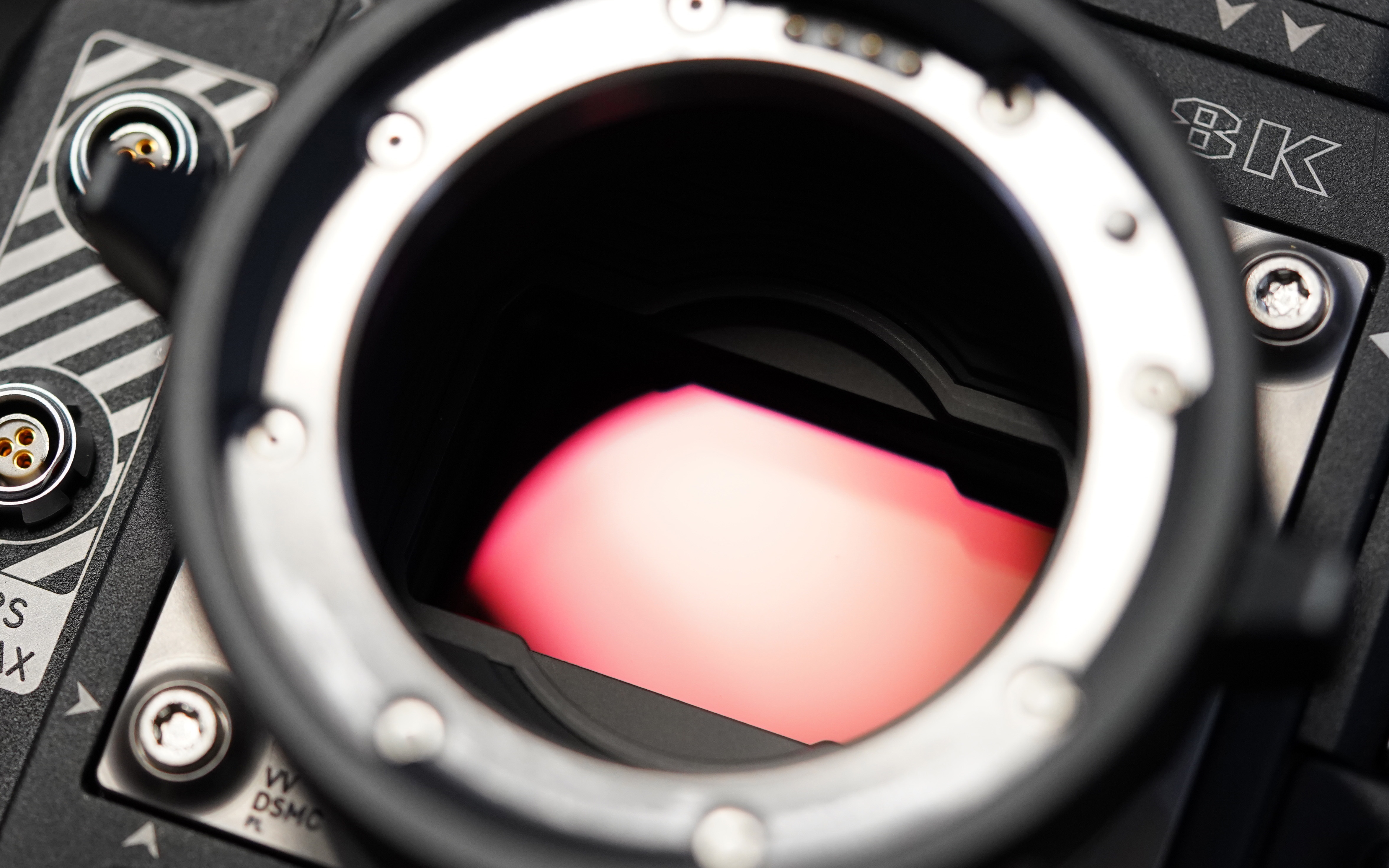
Part 1: EF and FE Mount Cine Cameras
Consider, if you will, the fate of Poor Ben. Unbeknownst to Poor Ben, Aaron and I had started experimenting with measuring the flange-to-sensor distance of various video cameras, since we found that it varied more than, well, more than we had thought it should vary. We spent some time developing techniques and methods, and said to ourselves, “Selves, we really need to measure hundreds of cameras if we want to seriously figure this stuff out.” Then we looked at each other and laughed and laughed. Because we ain’t got time for that.
Soon after that, Covid-19 happened, and two of its many consequences directly affect the story of Poor Ben. First, people stopped renting gear, and our warehouse filled with an amount of equipment that would seriously boggle your mind. Second, Lensrentals kept all their employees working safely and paid, even though there wasn’t much for them to do. Seeing this, Aaron and I said to ourselves, “Selves, we should get one of the techs with nothing to do to measure the flange-to-sensor distance of all those cameras.” (Aaron and me, we probably have been working together for way too long.)
And so, Poor Ben got to spend a couple of weeks carefully measuring and remeasuring camera flange-to-sensor distance. And you thought you were bored during isolation.
Why In the World Does Flange to Sensor Distance Matter?
Well, our original thinking was it doesn’t matter if you shoot photo, since photo lenses all focus past infinity, and nobody expects the distance scales to be accurate. We found out, as we often do, that our thinking was wrong less correct than we hoped. But that will come later.
For video, though, it can matter. Video lenses have accurate distance scales; if you set it at 17 feet, it should be in perfect focus at 17 feet. Plus, they usually have hard stops at infinity, so unlike photo lenses, you can’t focus past infinity. When you slam it to infinity, if it’s really focusing at 32 feet, guess what? You can’t get infinity in focus at all.
Below is a center crop from a 20mm f1.4 lens, slammed to the infinity stop. At a glance, you might just think it’s a bad lens, really soft. If you look at the lower right electrical outlet though, you might realize it’s not hitting infinity.

Joey Miller, 2020
Here is the same lens on the same camera, again at the infinity stop. This time, however, the lens was properly shimmed for the camera.

Joey Miller, 2020
Now, the video savvy among you are already thinking, “But that’s why video lenses are adjusted for focus accuracy,” and you are correct. Although, like Aaron and me, you are, perhaps, not as correct as you hope. Video lenses have a shim set or other adjustment that lets a technician accurately adjust the lens so that it focuses perfectly at infinity and accurately throughout the range of the distance scale. Our techs do that all day, every day.
The question, though, is accurately on what? The obvious answer is, of course, accurately on your camera. But the more important question is, “If I perfectly adjust the lens on my camera, is it adjusted for other cameras? If I adjust it to my Sony FS7, will it be accurate on Joe’s Sony FS5? Or, even more subtly, if I adjust it perfectly on this C300, will it be perfect on this other C300? You’ve probably guessed (or know) that the answer to at least some of the above questions is no, no it won’t.
If you’re used to high-end video or PL mount video cameras, where the lens mount is interchangeable and shim-adjustable on the camera, or the flange-to-sensor distance is field adjustable, these questions don’t matter to you. But if you use mid-range video cameras, where the flange-to-sensor distance is what it is, they can matter a great deal.
We knew flange-to-sensor distance mattered, of course, and we knew it varied some. But we didn’t have a clue on how often it varied, or by how much. We made accurate test lenses on our optical benches, which measure backfocus distance very accurately. So we knew sometimes cameras seemed off, but we had never tested ALL of the cameras at once to get an idea of how much they varied. Plus, measuring on a test lens, while pretty accurate, is a bit slow and doesn’t translate easily to numerical data.
How Accurate is Possible?
Cinema lens manufacturers furnish shim sets and tables so that techs can accurately set the flange-to-focus distance of the lens to about 0.01mm (it varies by manufacturer and lens a bit). That suggests that the flange-to-sensor distance of an EF mount (44mm) should theoretically be between 43.99mm and 44.01mm. That sounds impressive, but what does 0.01mm mean?
There are variables that affect what that means when actually imaging. The two big variables are 1) the focal length of the lens and 2) focusing distance at which you are testing.
Focused at 1.5 meters distance, An 85mm lens changes focus position just 2mm for every 0.01mm shim adjustment. That doesn’t sound like much. But the wider the lens, the greater the change. A 50mm changes focus position about 5mm (1/4″) for every 0.01 in shim difference at 1.5 meters. A 35mm lens at a 1-meter focusing distance changes about 1/2″ while a 15mm lens changes 2″ for each 0.01mm change in flange-to-sensor distance. Focusing further away makes the change greater.
I know what some of you are thinking. “So your distance scale is off a couple of inches. Be a big boy and cope,” you say. But here’s the critical thing: If your flange-to-sensor distance is longer than it should be by a few hundredths of a mm, then wide-angle lenses won’t reach infinity focus. (If you have a photo background, think of extension tubes where you gain closer focusing but lose infinity focus by increasing the flange to sensor distance.)
This may not matter, since you may not be focusing your wide-angle lens near infinity. But if you want to do that, and you can’t, then you will, as we say at Lensrentals, be an unhappy customer.
Cinematographers and videographers using top-end equipment realize this, of course, and they realize the flange-to-sensor distance varies between cameras. (Although if you ask how much it varies, the answer you’ll always get is ‘some’.) This is the reason that they shim each lens to the particular camera (not type of camera) it will be shot on. It’s also the reason some high-end video cameras have a mechanism that allows flange-to-sensor adjustment in the field.
But most mid-to-upper range video cameras, especially ones in photo mounts (rather than PL mounts), don’t provide that option.
So What Did We Do?
Up until now, we’d done what a lot of people do: use a test lens and test camera. Do you see the Catch-22? You adjust the test lens on a camera. You don’t know exactly what the test camera’s flange-to-sensor distance is. You use that lens to check other cameras. As I mentioned, we had the capability to set the lens back focus distance very accurately using an optical test bench, so we knew there was variation. But we didn’t know exactly how much variation there was on different cameras.
We knew the manufacturers wouldn’t (or couldn’t) tell us how much variation their cameras had. So we decided to do a large-scale test of hundreds of cameras; because we had hundreds of cameras, and we had Poor Ben.
We invested in a Denz Flange Depth Controller that allows us to measure flange depth to the nearest 0.01mm in actual numbers. Since we aren’t trusting souls, Aaron and I spent a month confirming it’s accuracy with test lenses and even some modified depth gauges. It’s accurate, it’s reproducible, and it’s fast. If you have the need and the money (about $10,000 for a complete set up), I recommend getting one. And no, they don’t give me anything to say that.
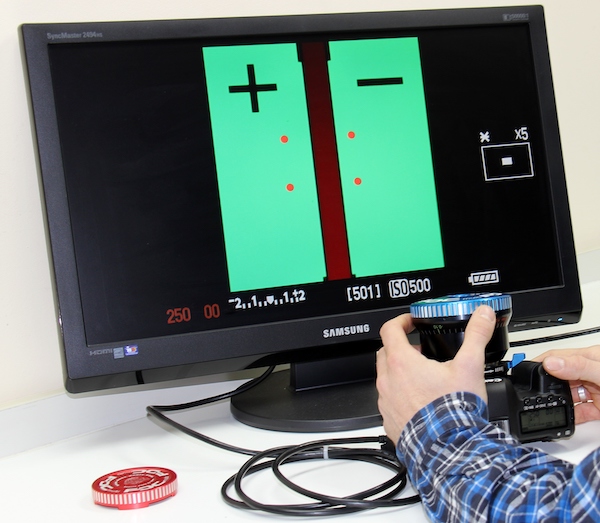
Courtesy Präzisions-Entwicklung DENZ Fertigungs GmbH
Finally, as mentioned in the intro, we trained Ben and made him spend weeks of his life measuring and documenting the flange-to-sensor distance for what ended up being a couple of thousand cameras. Yes, thousands. Cause sometimes you gotta make sacrifices to do science. Or sacrifice someone to do science — something like that.
I won’t argue that there might be better articles about flange-to-sensor distance. They might be more amusing. They might be more scientific. But I’m damn sure they won’t have data from 2,500 cameras worth about $10,000,000.
So What All Did We Find?
We found that we can improve our testing in a lot of ways, that’s what. I’ve spent a decade improving our testing. The first rule of ‘improving’ is, well, the older ways weren’t as good as the newer ways. (The second rule of ‘improving’ is the new ways are always more expensive than the old ways, but you don’t care about that. Tyler does, though). Anyway, first I’m going to show you that we weren’t doing as well as we thought we were.
Before I do that, a word about the measurements we’re using. The graphs give the Denz measurements because they were the most accurate and are similar for all mount types. The Denz tells you how much you need to change the mount shims (if you could, which for these cameras you can’t). So if the Denz reading for an EF mount camera (supposedly 44.00mm) is -0.02 it’s telling you that you need to remove 0.02mm of shim. Or put another way, the actual flange-to-sensor distance is 44.02mm.
Canon EF Cine Cameras
We started with a couple of hundred EF mount Canon Cxxx video cameras. I grouped them all together here, but we did, of course, evaluate each type (C200, C300, etc.) separately to make sure there were no differences between types. There weren’t.
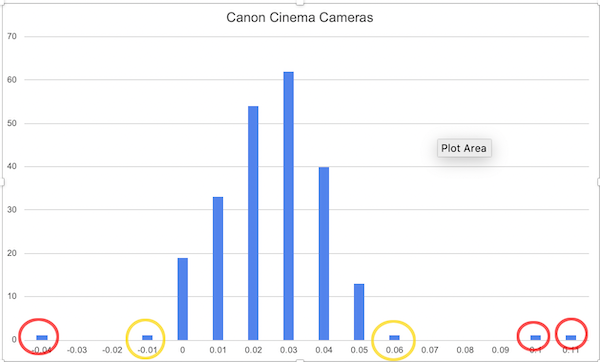
Lensrentals.com, 2020
The first thing that should jump out at you is that 3 of these things are not like the others (red circles). Being a junior rocket scientist detective, I looked up the history of those three cameras. The two on the right had both had sensor work done at the service center in the past, so both got sent back to the service center for re-adjustment. (Note: the service center corrected both; they came back fine.) The one on the left (-0.04) had not had any work or damage documented. However, simply replacing the mount in-house returned it to 0.01mm, so we assume the mount was slightly bent or bowed.
The two circled in yellow are a bit more difficult to call. Are they just the normal range, or are they out of spec? The statistical analysis said they were within spec, but I checked them just to be sure. They had no history of problems, and a careful tech inspection seemed fine, so we went with ‘edge of normal range’.
So, after eliminating the three we identified as out-of-specification, we end up with a graph of over 200 ‘good’ Canon Cine cameras that looks like this:

Lensrentals.com, 2020
Statistics confirms what you obviously see already; the mean of Cxxx Camera flange-to-sensor distance is 43.97mm +/- 0.03mm. (Remember, a Denz reading of +0.03 means you need to add 0.03mm of shim to get to zero.)
I think the big takeaway here is adjusting a lens on one Cxxx camera does not guarantee the lens is accurate on another Cxxx camera. Remember, being within 0.01mm is what the lens maker would consider as good as is possible.
If we picked an ‘average’ camera to adjust our lens perfectly (-0.03mm), then about 15% of the other cameras would be off by 0.02mm or more mounted to that lens. Being off by 0.02mm might make a noticeable (although rarely significant) difference in distance scale marks.
With some in-house testing, we found that it takes a 0.03mm difference before even the widest lenses can’t reach infinity focus. You could definitely see that ‘0.03mm or greater’ problem if the camera you used to set your lenses was in one direction, the camera you actually used that lens on was in the other. For example, if we used one of the +0.04 cameras to adjust lenses (very possible given the old way we did things), and then a customer mounted it to a +0.0 camera, the problem could be noticeable.
I can’t tell you statistically how frequently that happens. (Yes, I know I could if I had more math and the time to use it, but I don’t on either. Math guys feel free to do the statistics as a comment). I can tell you that it does happen, because well, we’ve seen it, and that’s what motivated us to improve things. So now our protocol requires we pick an 0.02 or 0.03 camera to adjust lenses with.
Sony FE Cine Cameras
The second-largest group of not-backfocus-adjustable video cameras we have are Sony. Of course, they have a different flange-to-focus distance than the Canons, but since we’re graphing the expected distance as 0.00 and using the Denz numbers, the graphs are similar.
There were 3 Sony cameras out of 137 tested that were huge outliers, using the same criteria as we used on the Canon cameras. That frequency was about 2% for each brand, and remember these are all rental cameras that have been used. I was a little disappointed that 2% of our cameras were not OK, but I can’t say I was shocked. This is why we decided this needed to be looked at.
Looking at the remaining cameras, the first thing we notice is the Sony Cine cameras overall look far more spread out than the Canons.
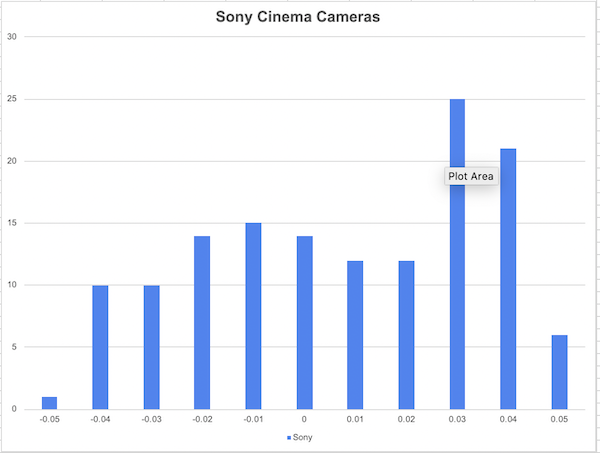
Lensrentals.com, 2020
In this case, separating them out by camera type is worthwhile. You can see below that each type of Sony camera (with one exception not in this graph) tends to be grouped rather closely, but they aren’t all grouped around the same point.
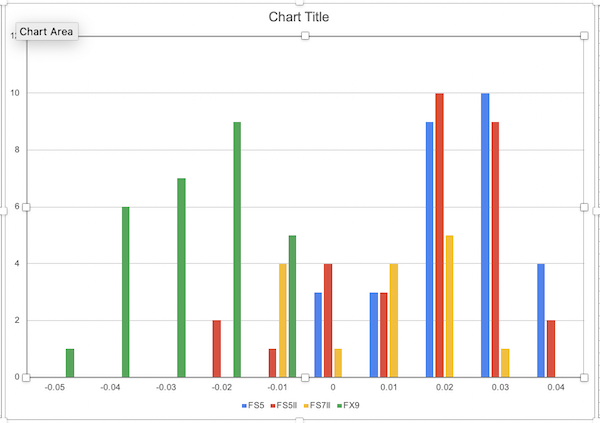
Lensrentals.com, 2020
The FX9 cameras were significantly different than the others. We confirmed this with test lenses (and a few with depth gauges). Why this is so I can’t say with certainty (I asked Sony; they haven’t responded yet). There were twenty-six FX9 copies tested, so I don’t think the sample size is too small to draw the conclusion. All 26 copies, though, were purchased over a two month period, so it’s possible copies manufactured later might be different.
The takeaway for us is that while FS5, FS5II, and FS7II cameras all average around +0.02, which is similar to Canon Cine cameras, the FX9 cameras average -0.025. Adjusting a lens on an FX9 almost guarantees it will be out of spec on the other Sony cameras, and vice-versa.
There is one more Sony camera group I mentioned that wasn’t included in the above graph. Below is a separate graph of just the FS7 Mk I cameras. They are definitely more spread out, although, like the FX9, they trend to the negative side of our graph (that is, they have a longer back focus distance).
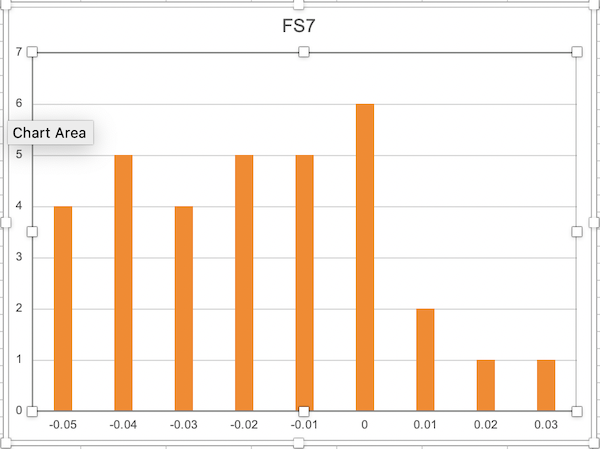
Lensrentals.com, 2020
Remember, these are not new-in-box cameras; they’ve been used. My first thought was perhaps the FS7s were older and therefore had seen higher use. We replace them pretty frequently, though, and when I checked, the only age difference among the various cameras was that the FX9s were newer (average 27 days rental; all the other Sony and Canon camera types, including FS7, averaged 100-115 days rental).
I think the most likely thing is the FS7, like the FX9, have a negative average, and the four cameras in the positive range are outliers. But examining both the history and really careful testing of those 4 showed nothing wrong. In fact, they were a bit newer and less used than the others. Why this is so, I can only speculate about; I don’t know. At least I don’t know yet.
Other EF Mount Cine Cameras
We have a few non-Canon brands of EF mount Cine cameras in stock, and it’s interesting to see how these graph out.
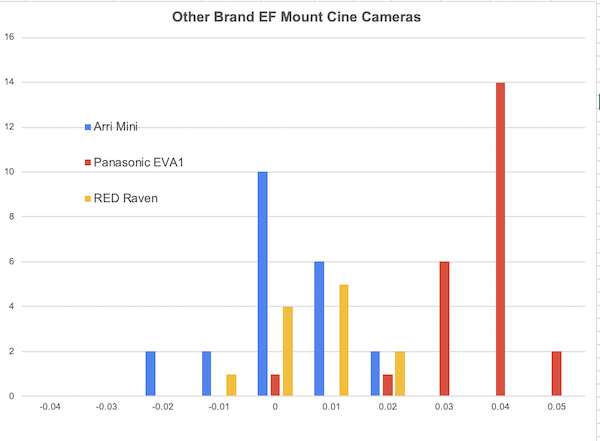
Lensrentals.com, 2020
The Arri Mini, Panasonic EVA1, and RED Raven each have a similar variation, but the Panasonic has a different average point than the other two. There is one ‘iffy outlier’ among the Panasonics, but careful inspection of the camera and its history were normal. I should note the Arri Minis are flange adjustable, which we did inhouse. I included them as an example of how accurate we were using our older ‘test lens’ methods. Using the Denz, we’ve readjusted them and now all measure at 0.00 or +0.01.
Last, we’ll look at the Black Magic cameras. The Studio Cameras are tightly grouped (although very much on the positive side), the micro-cinema cameras are a bit less positive but still grouped, and the Pocket 4k cameras pretty spread out.
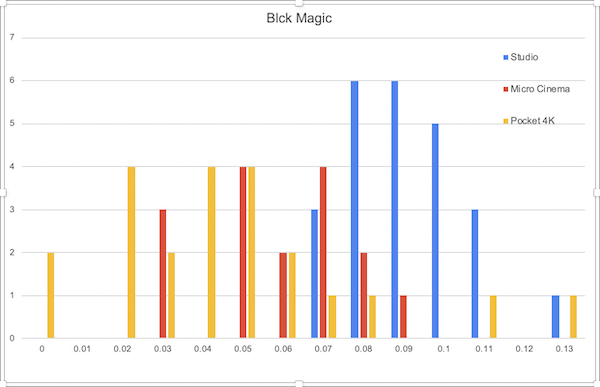
Lensrentals.com, 2020
The little Pocket Camera are awesome cameras and a great value, but you don’t get the same robust build and accurate flange to focus distance that you hope for in a camera costing ten times as much. (As an aside, these actually had a bit less rental use than most Cine cameras, averaging 70 days each.) Also, of course, these are SLR style cameras, which leads us to the question of the next article: how much variation is there in flange-to-sensor distance among SLR cameras?
So What Did We Learn Today?
Well, first of all, those of us here at Lensrentals learned we could do a better job of screening outlier cameras, ones that are truly out of spec. And that, for those cameras we can adjust flange-to-sensor distance on, we can tighten up the range.
We also demonstrated pretty clearly that the range for non-adjustable Cine cameras is about +/- 0.02mm; the camera mounts have a larger range of variation than the lenses that mount to them. This probably is not noticeable with the exception of very wide-angle lenses. Even then, it’s probably only of critical importance if you plan to focus wide-angle lenses at infinity. In that case, it is important that the actual lens be adjusted to, or at least checked on, the specific camera it will be mounted on.
We also found that while a camera type may have a +/- 0.02mm range, the ‘mean point’ might be different. For example, the average Sony FX9 is -0.025mm, while most Sony video cameras are at +0.02mm. Using a lens that was adjusted for one type of body on the other body type is likely to cause you problems.
You probably noticed there are no PL mount cameras in this post. The reason for that is that is while we checked them, almost all the PL mount cameras we stock have adjustable flange-to-sensor distances; they aren’t dialed in permanently at the factory. We were more interested in the variation for cameras that we couldn’t adjust.
Finally, you probably also noticed most of the m4/3 cameras aren’t here either. That’s because the m4/3 bodies we rent most for video (Panasonic GH5, Olympus OM-D E, etc.) are SLR style bodies, and we’re going to look at those in Part II. To be honest, although the Cine cameras were the reason we started this, the SLR cameras had much more interesting results.
Roger Cicala, Aaron Closz, and ‘Poor’ Ben Berggren
Lensrentals.com
June, 2020
Author: Roger Cicala
I’m Roger and I am the founder of Lensrentals.com. Hailed as one of the optic nerds here, I enjoy shooting collimated light through 30X microscope objectives in my spare time. When I do take real pictures I like using something different: a Medium format, or Pentax K1, or a Sony RX1R.
-
max_sr
-
Athanasius Kirchner
-
Rick
-
Roger Cicala
-
Mark Rustad
-
Roger Cicala
-
J.L. Williams
-
J.L. Williams
-
valium12
-
Clayton Taylor
-
Roger Cicala
-
Roger Cicala
-
MrGavin
-
DrJon
-
Someone
-
ProfHankD
-
TheDeepFurtherFact
-
Roger Cicala
-
Roger Cicala
-
ProfHankD
-
Andre Yew
-
TheDeepFurtherFact
-
Stefanie Daniella
-
LensHead
-
whereisaki
-
Roger Cicala
-
LensHead
-
Brandon Dube
-
Roger Cicala
-
Andre Yew
